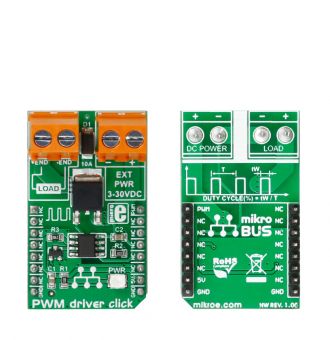
We strongly encourage users to use Package manager for sharing their code on Libstock website, because it boosts your efficiency and leaves the end user with no room for error. [more info]

Rating:
Author: MIKROE
Last Updated: 2019-03-13
Package Version: 1.0.0.1
mikroSDK Library: 1.0.0.0
Category: PWM
Downloaded: 6888 times
Not followed.
License: MIT license
If you need to control DC motors with loads up to 10A, PWM driver click is the perfect solution, thanks to the Silicon Lab Si8711CC one-channel isolator. It communicates with the target MCU over PWM pin, and runs on a 5V power supply.
Do you want to subscribe in order to receive notifications regarding "PWM driver click" changes.
Do you want to unsubscribe in order to stop receiving notifications regarding "PWM driver click" changes.
Do you want to report abuse regarding "PWM driver click".

Library Description
The library covers all the necessary functions to control the PWM driver Click board. PWM driver Click communicates with the target board via the PWM module. This library contains drivers for PWM function: initialization, for sets duty ratio, starts and stops PWM module.
Key functions:
Examples description
The application is composed of three sections:
void applicationTask()
{
mikrobus_logWrite( " Light Intensity Rising ", _LOG_LINE );
Delay_1sec();
for ( dutyCycle = 5; dutyCycle < 255; dutyCycle += 25 )
{
pwmdriver_pwmSetDuty( dutyCycle );
mikrobus_logWrite( " >", _LOG_TEXT );
Delay_1sec();
}
mikrobus_logWrite( "", _LOG_LINE );
mikrobus_logWrite( "-------------------------", _LOG_LINE );
mikrobus_logWrite( " Light Intensity Falling ", _LOG_LINE );
Delay_1sec();
for ( dutyCycle = 255; dutyCycle > 5; dutyCycle -= 25 )
{
pwmdriver_pwmSetDuty( dutyCycle );
mikrobus_logWrite( " <", _LOG_TEXT );
Delay_1sec();
}
mikrobus_logWrite( "", _LOG_LINE );
mikrobus_logWrite( "-------------------------", _LOG_LINE );
Delay_1sec();
}
Additional Functions :
Other mikroE Libraries used in the example:
PWMUARTAdditional notes and informations
Depending on the development board you are using, you may need USB UART click, USB UART 2 click or RS232 click to connect to your PC, for development systems with no UART to USB interface available on the board. The terminal available in all MikroElektronika compilers, or any other terminal application of your choice, can be used to read the message